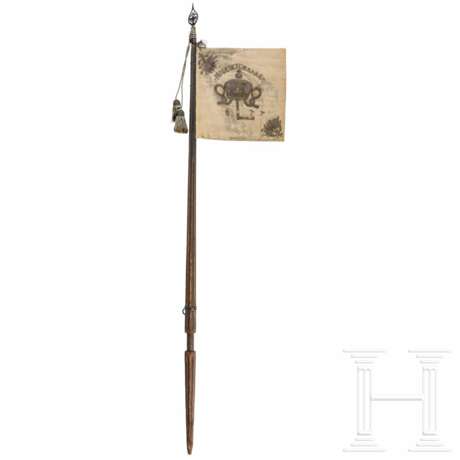Kürassier-Leib-Standarte mit Fahnenspitze, -stange und -quasten aus der Regierungszeit Kaiser Leopolds I. von Österreich, 1658 - 1705
27.10.2022 10:00UTC +01:00
Classic
Starting price
3800EUR € 3 800
| Auctioneer | Hermann Historica |
|---|---|
| Event location | Germany, Grasbrunn / München |
| Buyer Premium | 25 % |
Archive
The auction is completed. No bids can be placed anymore.

ID 835329
Lot 4160 | Kürassier-Leib-Standarte mit Fahnenspitze, -stange und -quasten aus der Regierungszeit Kaiser Leopolds I. von Österreich, 1658 - 1705
Estimate value
€ 3 800
Zu etwa 40 % einseitig erhaltenes Standartentuch aus weißem, geblümtem Seidendamast, restauratorisch in den 1960er Jahren auf lachsfarbenem Seidentuch montiert. Zudem in erhabener Silber- und Goldstickerei (altersbedingt gedunkelt) erhalten die Chiffre "L" unter der Kaiserkrone und zwischen geteilter Datierung "(1)6 - 77" über der Krone die Devise "Pro Deo et Caesare". Zwei der en suite gefertigten vier Eck-Palmetten (links oben und rechts unten) ebenfalls erhalten. Maße des lachsfarbenen Seidentuchs ca. 52 x 50 cm, ursprüngliche Maße des Standartentuchs ca. 50 x 48 cm. Unter schützendem Seidengaze.
Die Fahnenspitze aus Eisen, das Blatt mit durchbrochenem Doppeladler, konische Tülle. Gesamthöhe 23 cm.
Die Fahnenstange aus Fichtenholz mit überwiegend erhaltener grauer Farbfassung, in der Form an eine ritterliche Turnierlanze angelehnt mit kleiner Handhabe im unteren Viertel, achtfacher Kehlung, seitlicher eiserner Reitstange mit Ösen sowie vier eisernen Schaftfedern. Die Nägel der Federn sowie die Tülle mit floral gepunzten Köpfen, die Schrauben der Reitstange mit bombierten Köpfen. Gesamtlänge mit Standartenspitze 252,5 cm.
Um die Tülle der Spitze gewickelte, wohl ehemals schwarz-gelbe Kordel mit zwei Quastenabschlüssen, die Fransen einer Quaste nur noch teilweise erhalten. Von allergrößter Seltenheit.
Vgl. Peter Jaeckel, Kaiserliche Standarten in Ingolstadt, in Militaria Austriaca, Band 4 der Gesellschaft für österreichische Heereskunde, 1983. Darin werden neben dieser Standarte vier weitere im Bestand des Armeemuseums in Ingolstadt beschrieben, dort befinden sich eine weitere Leibstandarte mit weißem Tuch und drei Ordinärstandarten mit rotem Tuch. Allen fünf Standarten gemein ist, dass vom Standartentuch jeweils nur eine Seite vorhanden ist. Jaeckels Vermutung ist, dass die Doppeladler- bzw. Madonnenseiten der Standarten ab 1705 durch das von Österreich besetzte und durch den Krieg finanziell geschwächte Bayern aus Kostengründen für neu anzufertigende Standarten verwendet wurden, wohingegen die Seiten mit der Chiffre Kaiser Leopolds I. nach dessen Tod 1705 unbrauchbar wurden.
Provenienz: Wie auch die vier Standarten im Bayerischen Armeemuseum in Ingolstadt stammt diese Leibstandarte höchstwahrscheinlich aus dem Gefecht bei Schardenberg und Eisenbirn am 11. März 1703, als Truppen des bayrischen Kurfürsten Maximilian Emanuel das Corps des österreichischen FML Leopold Schlick angriffen und bezwangen. Das einzige Kürassierregiment auf österreichischer Seite war dabei das 1663 als "Garnier-Cürassiere" gegründete Regiment, das ab 1697 Cürassier-Regiment "Jung-Hannover" hieß.
Allegedly captured in the War of the Spanish Succession during the battles at Schardenberg and Eisenbirn on 11 March 1703 by electoral Bavarian troops from the Austrian Cuirassier Regiment "Jung-Hannover".
Standard cloth of white silk damast with flower pattern, only one side preserved at approx. 40%, mounted on salmon-coloured silk cloth in the 1960s for restoration purposes. Cypher "L" in raised silver and gold embroidery (darkened by age) underneath the imperial crown, and motto "Pro Deo et Caesare" between divided date "(1)6 - 77" above the crown. Two of the four corner palmettes crafted en suite (upper left and lower right) equally preserved. Dimensions of salmon-coloured silk cloth approx. 52 x 50 cm, original dimensions of the standard cloth approx. 50 x 48 cm. Under protective silk gauze. The pole top of iron, the finial with openwork double-headed eagle, tapered socket. Overall height 23 cm.
The pole of spruce wood with largely preserved grey paint, the shape similar to that of a knightly jousting lance with small handle in the lower quarter, eight grooves, on the side iron cavalry staple with eyelets and for iron side straps. The nails of the side straps and the socket with heads punched with flower ornaments, the screws of the cavalry staple with domed heads. Overall length with standard top 252.5 cm.
A cord terminating in two tassels, whose original colours were probably black and yellow, is wrapped around the socket of the pole top, the fringes of one tassel are only preserved in parts. Of utmost rarity.
Cf. Peter Jaeckel, Kaiserliche Standarten in Ingolstadt, published in Militaria Austriaca, vol. 4 by the Austrian Society for Army Science, 1983. In addition to the standard at hand, this publication describes four further standards on display in the Ingolstadt Army Museum, i. e. a further life standard with white cloth and three ordinary standards with red cloth. All five standards have in common that only one side of the standard cloth is preserved. Jaeckel assumes that the sides displaying the double-headed eagle or the Madonna from 1705 onwards were used by Bavaria, at that time occupied by Austria and financially weakened by the war, for newly manufactured standards for financial reasons, whereas the sides showing the cypher of Emperor Leopold I became unusable after his death in 1705.
Provenance: As the four standards displayed in the Bavarian Army Museum in Ingolstadt, this life standard probably stems from the battles at Schardenberg and Eisenbirn on 11 March 1703, when troops of the Bavarian Elector Maximilian Emanuel attacked and defeated the corps of the Austrian Lieutenant Field Marshal Leopold Schlick. The only cuirassier regiment on the Austrian side was the regiment of the "Garnier-Cürassiere" established in 1663, which was renamed Cuirassier Regiment "Jung-Hannover" from 1697 onwards.
| Auction house category: | Austria: Empire |
|---|
| Auction house category: | Austria: Empire |
|---|
| Address of auction |
Hermann Historica Bretonischer Ring 3 85630 Grasbrunn / München Germany | ||||||||||||||
|---|---|---|---|---|---|---|---|---|---|---|---|---|---|---|---|
| Preview |
| ||||||||||||||
| Phone | +49 (0)89 5472 649 0 | ||||||||||||||
| Fax | +49 (0)89 5472 64999 | ||||||||||||||
| Buyer Premium | 25 % | ||||||||||||||
| Conditions of purchase | Conditions of purchase | ||||||||||||||
| Business hours | Business hours
|


